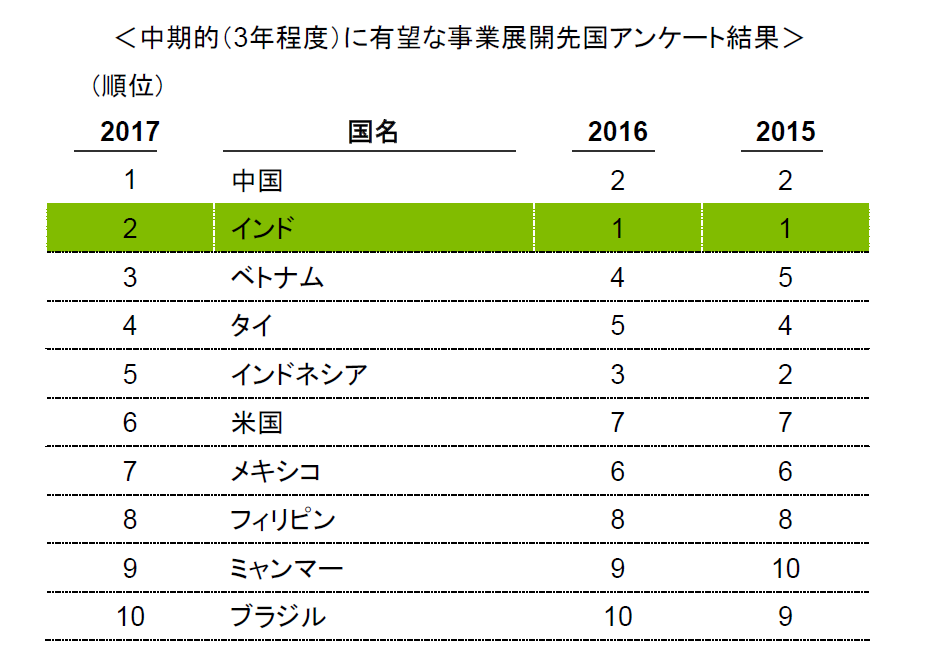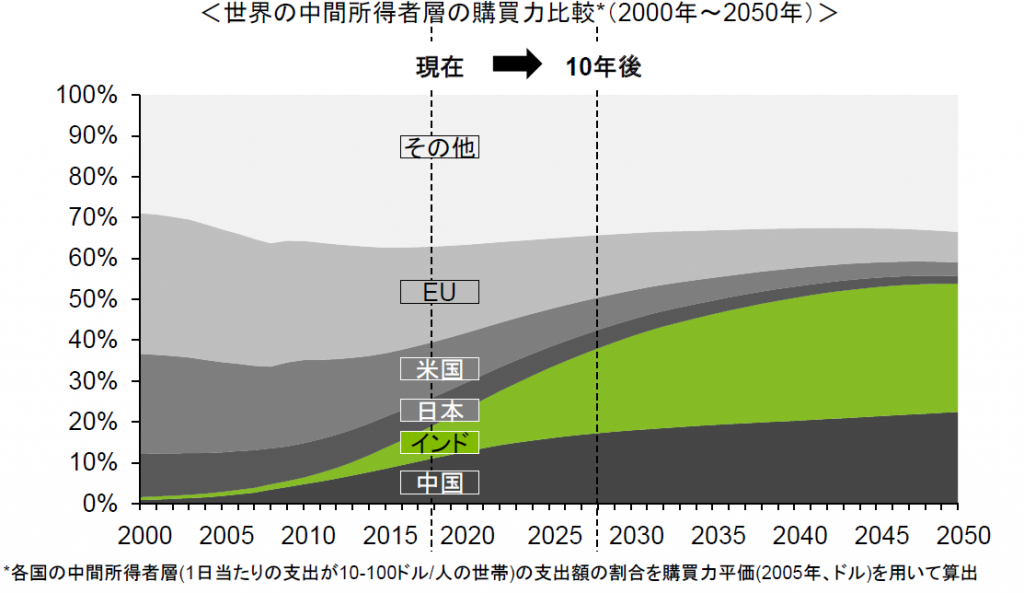India is a country where high economic growth can be expected
The Indian economy has the highest growth rate of around 7% among BRICs. Private consumption is the biggest driver of the Indian economy, and the market with a population of 1.3 billion has the potential to expand further in the medium to long term. Expectations of Japanese small and medium-sized enterprises’ excellent technologies and products in the Indian market are as follows.
Expansion of middle class
It is estimated that the number of middle class people in India (early income of about half to 2 millionJapanese yen and those who can buy home appliances eg.) will reach 800 millions by 2025. (Quoted from JETRO JETRO (Japan External Trade Organization) presentation material) Therefore, it can be seen that there are consumers who can purchase Japanese technologies and products, and these are also expanding.
Regional advantages and national policies
India is now aiming to be a manufacturing base with the phrase “make in india”. Products manufactured in India are being exported not only to Japan, but also to Europe, the Middle East and Africa, and are gradually beginning to establish themselves as manufacturing bases. In other words, there is a market environment that accepts new technologies and new materials.
Make in India is a focus on manufacturing that promotes job creation and exports, increasing manufacturing’s share of GDP from about 16% to 25%, and creating 100 million new jobs. Is a policy that aims to create Including deregulation of foreign capital and promotion of infrastructure development, we are actually creating a great deal of employment.
Expectations for R & D
India has many excellent researchers and technical personnel, but its labor costs are lower than those of developed countries.
Focusing on manufacturing to promote job creation and exports, this policy aims to increase manufacturing’s share of GDP from about 16% to 25% and create 100 million new jobs. Including deregulation of foreign capital and promotion of infrastructure development, we are actually creating a great deal of employment.
————————-
Trends in the Japanese market
Japan, the world’s third largest economy, is facing a declining population, with the number of children aged 65 and over doubling the number of children aged 15 and under. Due to the declining population, the Japanese consumer market is shrinking year by year, and Japanese companies are seeking new customers across borders. Despite the weakening of the yen since 2017, the M & A of Japanese companies by foreign companies in 2018 has reached a record high for the first time in nine years on a value basis.
Therefore the company’s sense of crisis regarding population decline indicates a strong desire to enter overseas markets and export overseas. According to JETRO’s survey results, 67.8% (see the figure below) of companies answered that they plan to expand exports, and 57.1% (see the figure below) said that they plan to expand overseas. Is.


Excerpted from the result summary document P10
As you can see, India’s economic growth is remarkable, and Japanese companies are highly motivated to export and enter the market.
————————-
Needs of Japanese companies to enter the Indian market
According to a 2017 study by the Development Bank of Japan, India has been ranked first and second in 2015 as a promising business destination in the medium term.


In addition, Japanese business owners have already found that the Indian domestic market is
We already understand that purchasing power is the greatest. In other words, we recognize that the country with the largest middle class in the world market is the Indian market. Therefore, if you have the opportunity and are ready, you can see that their willingness to expand is strong.
Needs of Indian companies to enter the Japanese market
There are many Indian companies that want to enter the Japanese market, and there are many companies that want to cooperate with Indian IT companies that have the most advanced IT technology and Japanese companies that have strength in manufacturing and product technology. Leading companies that have succeeded in forming alliances are promoting global expansion with innovative services using Indian engineers’ advanced IT technology.
Why Indian companies aim for the Japanese market
- Start-ups are more likely to succeed in IPO in Indian market if successful in Japanese market
- Capturing the Japanese market increases brand image in India
- The manager of an Indian company gains new skills and brushes up its own technicians by expanding into Japan. In addition, we understand that it contributes to improving the quality of our products
- I understand that the Japanese market has a strong purchasing power and that if the quality and design are good, they will be able to buy even if they are expensive.
- There is a strong admiration for high-performance Japanese products and technologies, high new products and new service needs
Thus, the Indian market is full of potential for success.
Why not try the Indian market?
